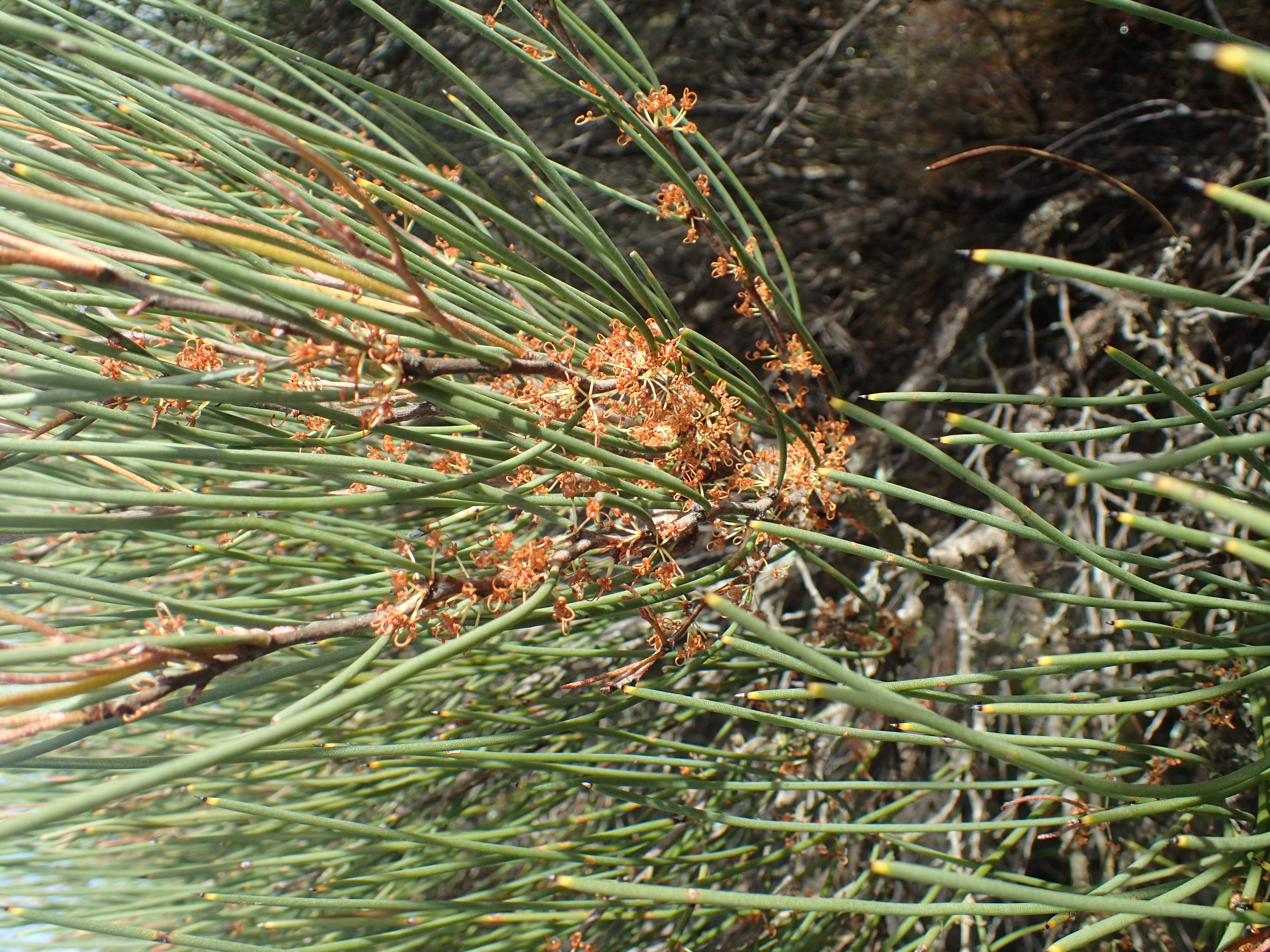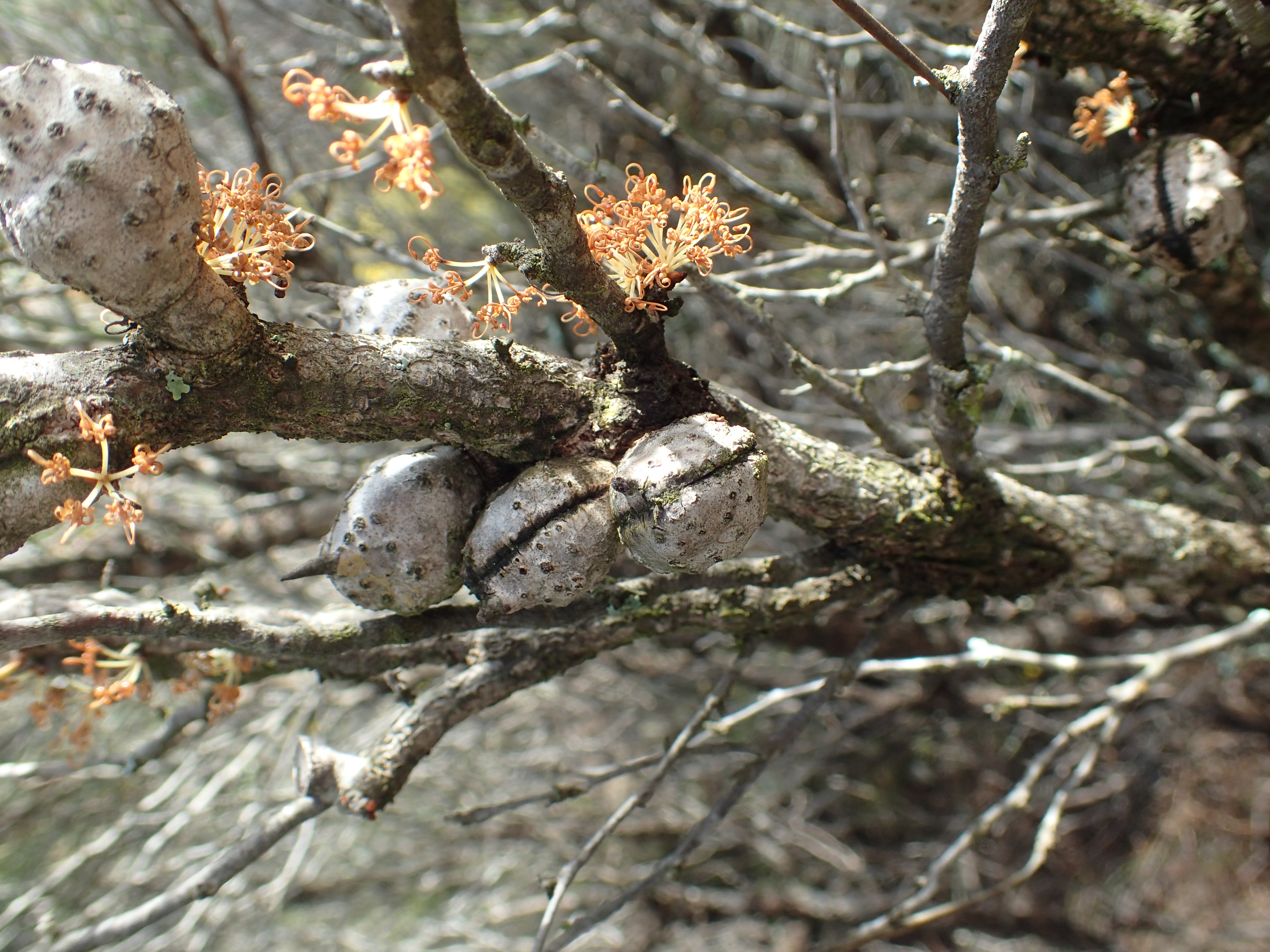Hakea Bicornata on:
[Wikipedia]
[Google]
[Amazon]
''Hakea bicornata'' is a shrub in the family 

Proteaceae
The Proteaceae form a family of flowering plants predominantly distributed in the Southern Hemisphere. The family comprises 83 genera with about 1,660 known species. Together with the Platanaceae and Nelumbonaceae, they make up the order Pro ...
native to Western Australia, with attractive creamy-white flowers and fruit with two distinctive horns.

Description
''Hakea bicornata'' is alignotuber
A lignotuber is a woody swelling of the root crown possessed by some plants as a protection against destruction of the plant stem, such as by fire. Other woody plants may develop basal burls as a similar survival strategy, often as a response t ...
ous, multiple stemmed shrub high. The many smaller branches are rusty coloured and covered with small hairs. The simple rust coloured leaves grow alternately along the stem; they are long and wide, ending in a point long. The young leaves are densely covered in matted silky hairs but become smooth as they mature. It produces cream-white to yellow flowers from April to May and occasionally August. Each inflorescence
An inflorescence is a group or cluster of flowers arranged on a stem that is composed of a main branch or a complicated arrangement of branches. Morphologically, it is the modified part of the shoot of seed plants where flowers are formed o ...
is composed of eight cream-white to yellow flowers on an obscure stem. The perianth
The perianth (perigonium, perigon or perigone in monocots) is the non-reproductive part of the flower, and structure that forms an envelope surrounding the sexual organs, consisting of the calyx (sepals) and the corolla (petals) or tepals when ...
is cream-white about long. The pistil
Gynoecium (; ) is most commonly used as a collective term for the parts of a flower that produce ovules and ultimately develop into the fruit and seeds. The gynoecium is the innermost whorl of a flower; it consists of (one or more) ''pistils'' ...
is about long with an oblique conical pollen presenter.
Fruit are oval to egg-shaped long and wide with a pair of distinctive narrow horns long. The fruit are pale grey with black blister-like protuberances. The dark brown to black egg-shaped seeds have a wing down one side.
Taxonomy and naming
''Hakea bicornata'' was first formally described by botanistR.M.Barker
Robyn M. Barker (born 1948) is an Honorary Research Associate of the South Australian Herbarium. She now works part-time, her duties include maintenance of the Vascular Plant Census for the State. Barker's research interests also include syst ...
in 1990 as part of the work ''New species, new combinations and other name changes in Hakea (Proteaceae)'' as published in ''Journal of the Adelaide Botanic Gardens''. The specific epithet
In taxonomy, binomial nomenclature ("two-term naming system"), also called nomenclature ("two-name naming system") or binary nomenclature, is a formal system of naming species of living things by giving each a name composed of two parts, bot ...
(''bicornata'') is derived from the Latin
Latin (, or , ) is a classical language belonging to the Italic branch of the Indo-European languages. Latin was originally a dialect spoken in the lower Tiber area (then known as Latium) around present-day Rome, but through the power of the ...
prefix ''bi-'' meaning "two" or "twice" and the word ''cornu'' meaning "horn", referring to the prominent horns on the fruit.
Distribution and habitat
''Hakea bicornata'' is found in coastal areas along the south coast Goldfields-Esperance region ofWestern Australia
Western Australia (commonly abbreviated as WA) is a state of Australia occupying the western percent of the land area of Australia excluding external territories. It is bounded by the Indian Ocean to the north and west, the Southern Ocean to th ...
between Esperance and Cape Arid National Park
Cape Arid National Park is a List of national parks of Australia, national park located in Western Australia, southeast of Perth. The park is situated east of Esperance, Western Australia, Esperance and lies on the shore of the South coast of W ...
in lateritic
Laterite is both a soil and a rock type rich in iron and aluminium and is commonly considered to have formed in hot and wet tropical areas. Nearly all laterites are of rusty-red coloration, because of high iron oxide content. They develop by ...
sandy-loamy soils over granite
Granite () is a coarse-grained (phaneritic) intrusive igneous rock composed mostly of quartz, alkali feldspar, and plagioclase. It forms from magma with a high content of silica and alkali metal oxides that slowly cools and solidifies undergro ...
as part of shrub-land communities.
Conservation status
''Hakea bicornata'' is classified as "not threatened" by the Western Australian GovernmentDepartment of Parks and Wildlife
The Department of Parks and Wildlife (DPaW) was the department of the Government of Western Australia responsible for managing lands described in the ''Conservation and Land Management Act 1984'' and implementing the state's conservation and e ...
.
References
{{Taxonbar, from=Q18079759 bicornata Eudicots of Western Australia Plants described in 1990 Taxa named by Robyn Mary Barker